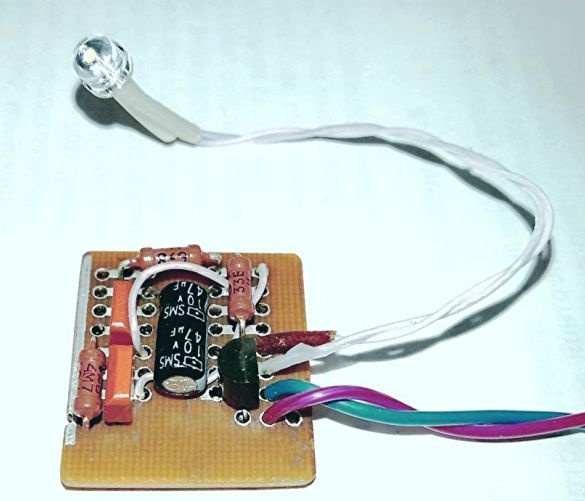
To one of the past homemade «Night lamp with acoustic switch"Received a comment with interesting suggestions for finalizing the design.

Since the battery discharge indicator (paragraph 3 of the commentary) is advisable to use on any autonomous electronic device, to exclude unexpected failures or equipment failure at the most inopportune moment when the battery is low, the manufacture of the discharge indicator is made in a separate article.
The use of a discharge indicator is especially important for most lithium batteries with a nominal voltage of 3.7 volts (for example, the 18650s that are popular today and similar or common flat Li-ion batteries from phones replaced with smartphones), because they very “dislike” a discharge below 3.0 volts and fail at the same time. True, emergency protection against deep discharge should be built into most of them, but who knows what kind of battery is in your hands until you open it (China is full of mysteries).
But most importantly, I would like to know in advance what kind of charge is currently available in the battery used. Then we could connect the charging in time or put in a new battery, without waiting for the sad consequences. Therefore, we need an indicator that will give a signal in advance that the battery will be completely exhausted soon. To implement this task, there are various circuitry solutions - from circuits on a single transistor to sophisticated devices on microcontrollers.
In our case, it is proposed to manufacture a simple lithium battery discharge indicator, which is easily assembled do it yourself. The discharge indicator is economical and reliable, compact and accurate in determining the controlled voltage.
Discharge indicator circuit
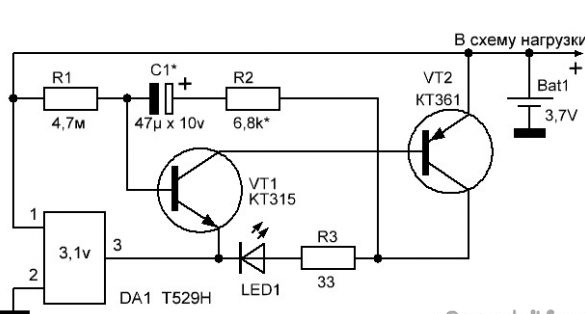
The circuit is made using so-called voltage detectors. They are also called voltage monitors. These are specialized microchips designed specifically for voltage control. The indisputable advantages of circuits on voltage monitors are the extremely low power consumption in standby mode, as well as its extreme simplicity and accuracy. To make the discharge indication even more visible and economical, we load the output of the voltage detector with a blinking LED or a “blinker” on two bipolar transistors.
The voltage detector (DA1) PS T529H used in the circuit connects the output (terminal 3) of the microcircuit with a common wire, while reducing the controlled voltage on the battery to 3.1 volts, including the power supply to the high duty cycle pulse generator. At the same time, a super-bright LED begins to flash with a period: pause - 15 seconds, short flash - 1 second. This reduces the current consumption to 0.15 ma during a pause, and 4.8 ma during a flash. When the voltage on the battery is more than 3.1 volts, the indicator circuit practically turns off and consumes only 3 μa.
As practice has shown, the indicated display cycle is quite enough to see the signal. But if you wish, you can set a more convenient mode for you by selecting a resistor R2 or capacitor C1. Due to the low current consumption of the device, a separate supply voltage switch for the indicator is not provided. The device is operable when reducing the supply voltage to 2.8 volts.
Charger manufacture
We purchase or select from available components for assembly in accordance with the scheme.
To check the operability of the circuit and its settings, we collect the discharge indicator on the universal circuit board. For convenience of observation (high pulse frequency), during the test, we replace the capacitor C1 with a capacitor of a smaller capacity (for example, 0.47 microfarads). We connect the circuit to the power supply with the ability to smoothly adjust the DC voltage in the range from 2 to 6 volts.
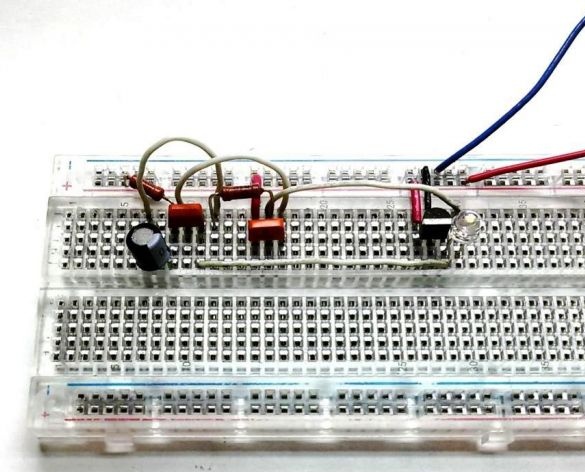
Slowly lower the supply voltage of the discharge indicator, starting at 6 volts. We observe the voltage value at which the voltage detector (DA1) turns on and the LED flashes. With the correct selection of the voltage detector, the switching moment should take place in the region of 3.1 volts.
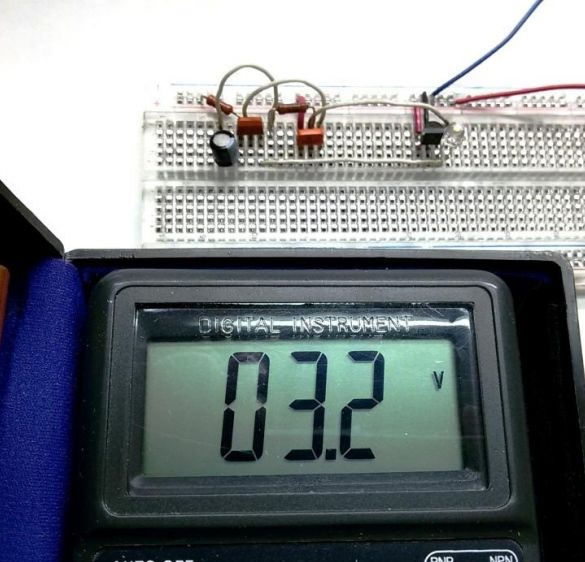
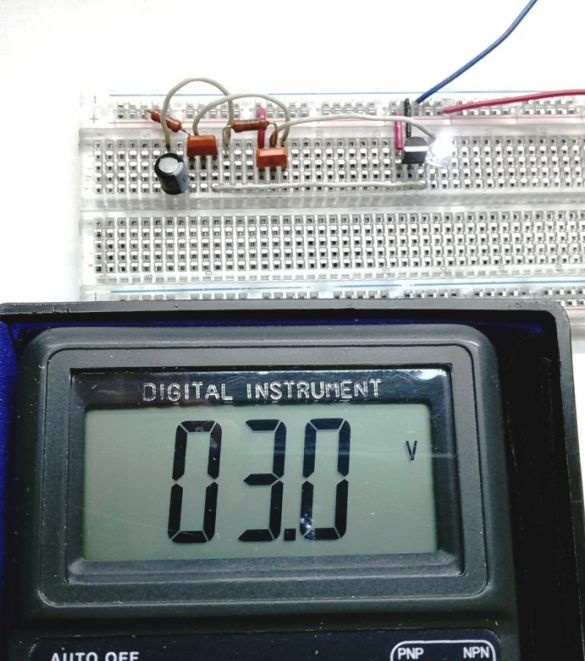
.
We cut out the piece necessary for installation from the universal printed circuit board, carefully process the edges of the board with a file, clean and tidy the contact tracks. The size of the cut-out board depends on the parts used and their layout during installation. The dimensions of the board in the photo are 22 x 25 mm.
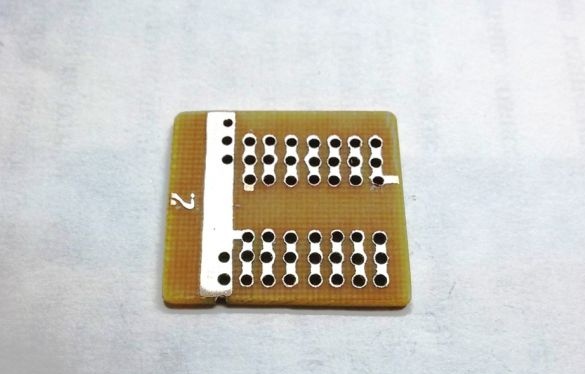
With a positive result in the operation of the circuit on the circuit board, we transfer the parts to the work board, solder the parts, perform the missing wiring of the connections with a thin mounting wire. At the end of the assembly, we check the installation. The circuit can be assembled in any convenient way, including mounted mounting.
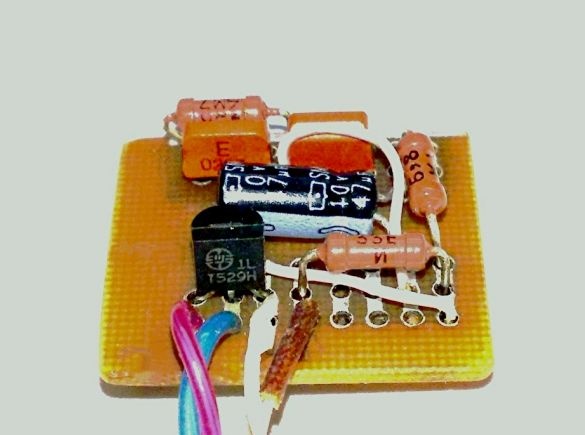
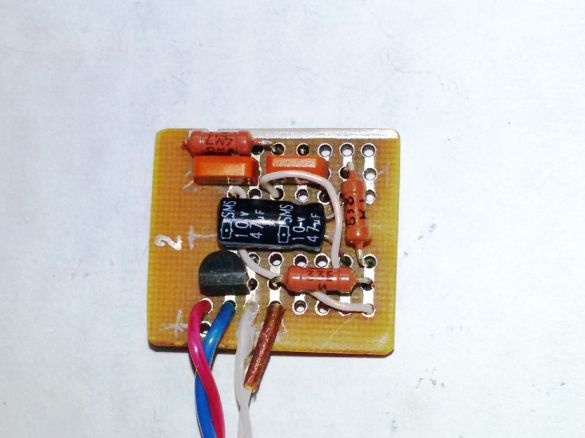
We check the performance of the discharge indicator circuit and its settings by connecting the circuit to the power supply, and then to the battery under test. When the voltage in the power circuit is less than 3.1 volts, the discharge indicator should turn on.
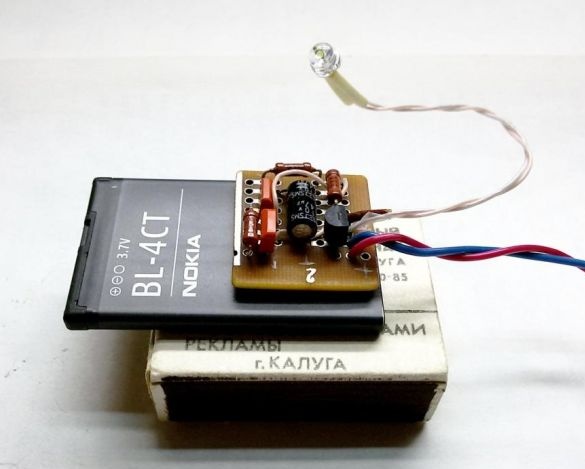
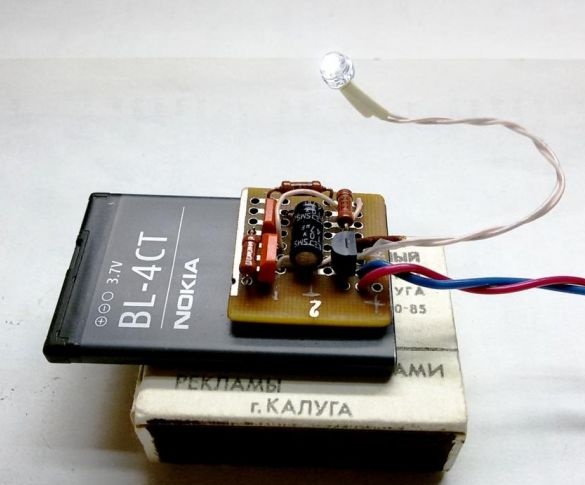
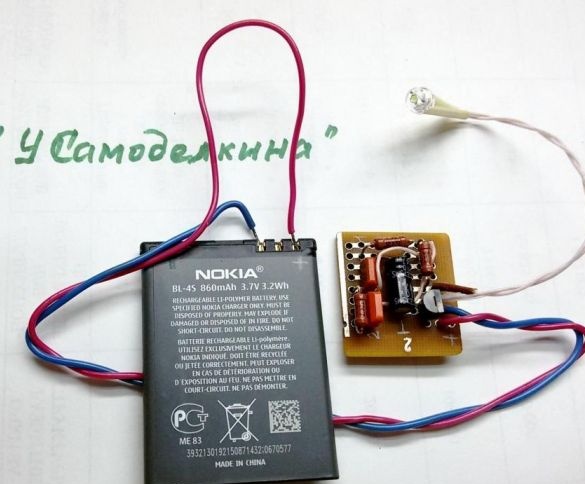
Instead of the PS T529H voltage detector (DA1) used in the circuit for a controlled voltage of 3.1 volts, it is possible to use similar microcircuits from other manufacturers, for example BD4731. This detector has an open collector at the output (as indicated by the additional digit “1” in the designation of the microcircuit), and also independently limits the output current to 12 mA. This allows you to connect an LED to it directly, without limiting resistors.
It is also possible to use detectors with a voltage of 3.08 volts in the circuit - TS809CXD, TCM809TENB713, МСР103Т-315Е / ТТ, САТ809ТТВI-G. The exact parameters of the selected voltage detectors are desirable to clarify in their datasheet.
Similarly, you can apply another voltage detector to any other voltage necessary for the indicator to work.
The solution to the second part of the question in paragraph 3 of the above comment - the operation of the discharge indicator only in the presence of illumination, is postponed the following reasons:
- the operation of additional elements in the circuit requires additional energy from the battery, i.e. the economy of the circuit suffers;
- the operation of the discharge indicator during the day, most often, is useless, because there are no “spectators” in the room, and by evening the battery may run out;
- the indicator is brighter and more efficient in the dark, and there is a power switch to quickly turn off the device.
The application proposed in paragraph 2 of the comment was not considered by the domestic operational amplifier, due to debugging of the operating modes of the circuit at minimum currents, in the process of fine-tuning on the circuit board.
To solve the problem according to p.1 comment, slightly changed the circuit of the device “Night lamp with an acoustic switch”. For this, I turned on the positive power bus of the acoustic relay through an inverter on VT3, with control from a constantly running photo relay.

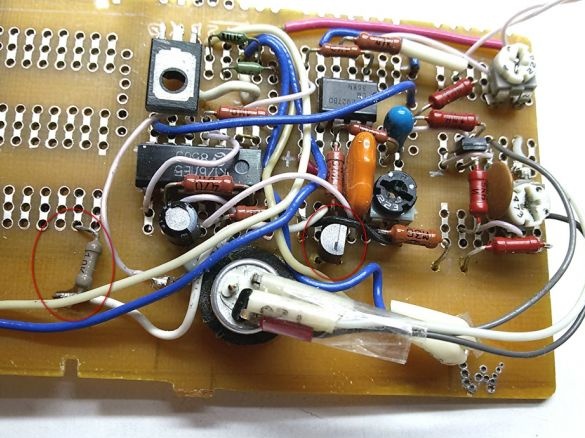
Thus, adding two parts (marked with an oval on the circuit board), we were able to partially turn off the acoustic relay during daylight hours. Partial shutdown because the various elements of both microcircuits work both in the acoustic and in the photo relay, but have a common power supply, therefore they are not completely turned off. Nevertheless, there is some effect on energy saving.
Prior to revision, the device circuit consumed 1.1 ma in standby mode.
After refinement, the device circuit consumes standby time in the daytime - 0.4 ma, in the dark - 1.7 ma (a difference of 0.6 ma is the VT3 work charge).
Thus, it can be considered that in the summer, the refinement is justified and provides savings, and in winter (when long nights) less profitable. But there is a simple solution - to shunt VT3 with a two-position switch “winter-summer” or “on-off”.

